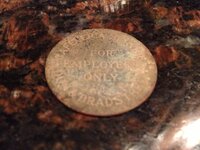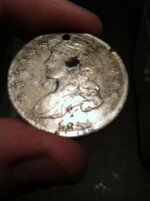strateloss
Sr. Member
- Aug 21, 2012
- 266
- 111
- Detector(s) used
- Minelab CTX3030, E-TRAC, ProFind25, Garrett Pro Pointer
- Primary Interest:
- Metal Detecting
Need some help ID'ing an older Token...
I found an interesting token in a very old park. I did some research, but found very little out about the name of the company. If any of the token gurus can help ID it, I'd really appreciate it.
It reads, Cafeteria Service " For Employees Only" 740 Dun & Bradstreet. I don't think it's super old, but it definitely looks older. A friend did find an 1835 half dollar about 20ft from me.
Here are pics of both.


Thanks guys....HH
I found an interesting token in a very old park. I did some research, but found very little out about the name of the company. If any of the token gurus can help ID it, I'd really appreciate it.
It reads, Cafeteria Service " For Employees Only" 740 Dun & Bradstreet. I don't think it's super old, but it definitely looks older. A friend did find an 1835 half dollar about 20ft from me.
Here are pics of both.


Thanks guys....HH


